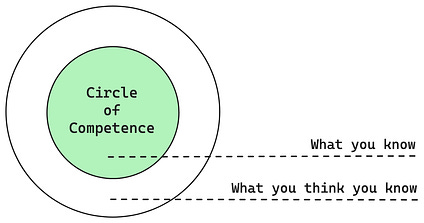Circle of Competence – Mental Model
When I was an engineer, I was involved in the discovery (or pre-sales) phase when working with potential clients. We initially estimated the development cost of products and assessed their feasibility. During this period I learned a lot about exploring my Circle of Competence.
The Circle of Competence is a mental model that reminds us about our knowledge boundaries. Warren Buffet and Charlie Munger coined the term for financial investments (only invest in assets that you understand) but I talk about its wider applications.
This is Perspectiveship. Sign up to receive a new engineering leadership perspective straight to your inbox, every week.
Everything we know lies in this green circle – this is our Circle of Competence and it is different for each of us. Outside of this circle is a bigger one that contains all the things that we think we know. The difference in this outer circle is determined by our ego.
Inside The Circle
Have you ever experienced a situation in which you were sure the task was easy but you ended up spending hours instead of minutes to finish it? In this situation you wandered outside of your Circle of Competence.
One of my biggest underestimations was when I was working on integration with an external system. I thought it would be an easy task, so I estimated that the work would require 2 weeks. However, I missed by quite a lot – it took 2 months to finish. I based my estimation on documentation that was outdated, and I was not familiar with the external system. It was outside of my Circle of Competence.
Inside the Circle of Competence we know what to do. We have expertise and we feel confident. Being aware of what we know is an important asset as it helps us make good decisions. Straying into the outer circle of things that we think we know can lead to an overconfidence in our abilities, as with my underestimation from the previous paragraph.
Drawing Circles of Others
Let’s do a thought experiment with actors observing the same entity. Imagine a forest dense with trees, and consider different perspectives:
-
For lumberjacks, the forest serves as a source of raw materials. They are skilled in the proper methods of chopping wood, storing it, and using it as a material.
-
For biologists, the forest represents life, trees, insects, and the entire ecosystem within its layer of forest litter. Their focus is the organisms that inhabit it.
-
For runners, the forest offers an excellent area for trail running. They are familiar with all the ideal courses for their 10k runs, knowing the terrain.
What is a forest? Each of these groups has its own Circle of Competence that contains their knowledge about the concept of a forest. A forest is a complex entity, and none of these personas fully grasp it. When dealing with a complex topic to understand it completely, help might be needed. It is beneficial to ask others with different points of view.
When seeking solutions to problems, we are constrained by our knowledge. Asking others for help, and considering their perspectives and viewpoints, can provide valuable insights.
There is one group I have not mentioned that connects all these areas – Foresters. They share some knowledge with all these groups to care for the forest. Foresters ensure we can obtain raw materials, protect biodiversity, and take into consideration the people who use the forest. This is an excellent example of multi-disciplinary thinking in problem-solving.
Summary
During the presales process we focused on estimating the costs of software development. In my early days, when I was just supporting this task, a more experienced engineer suggested that although our estimates were valid, we should consider offering a pre-existing solution which was outside of our Circle of Competence. This made me realise our limited perspective, and was an important lesson for the future: to take a step back and see outside of my expertise.
Be aware of what you are good at and where you lack expertise. Ensure you minimise the gap between what you think you know and what you actually know. Remember, the best solution to a problem may lie outside your Circle of Competence. So, ask and explore.
Thank you for reading!
Michał
PS In 2022, I started using the example of a forest in my talk on Mental Models. It has been helpful ever since in explaining the Circle of Competence and multi-disciplinary thinking.
PPS My interest in mental models has been growing over the years thanks to Farnam Street. Their podcast, The Knowledge Project, and their books. Circle of Competence was one of the first mental models I learned.


